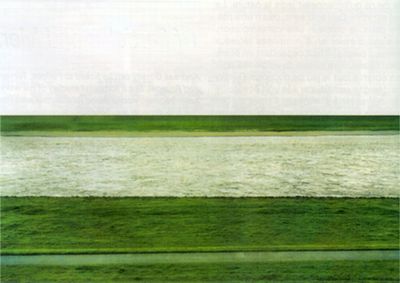Gilead is one of those rare novels that can broach deeply profound themes in its subject matter (specifically, an exploration of what it means to be Christian in the context of over a hundred years of racism in the United States) while still being a well-paced and engaging read. Taking the form of a letter written by an elderly pastors with a terminal heart condition to his young son, the novel relates the story of a family of pastors in the small town of Gilead, Iowa. The novel explores religious conviction and Christian faith, conflicts between fathers and sons, questions of forgiveness, and the historical legacy of slavery and the abolitionist movement, particularly in Kansas, and particularly tied to the radical actions of the Reverend John Brown, all woven gracefully into the autobiographical narrative of the fictional Reverend John Ames, and the lives of his father and grandfather. Gilead is also a deeply relevant novel, in that it explicitly tackles, both spiritually and practically, questions of faith, of the choices a person makes in raising a young family, of forgiveness, and of the racial tensions that still exist in this country. I hope its just not the latent country in preacher in me that responds to this book, because I whole-heartedly recommend it.
Thursday, May 31, 2007
Rave: Gilead by Marilynne Robinson
Gilead is one of those rare novels that can broach deeply profound themes in its subject matter (specifically, an exploration of what it means to be Christian in the context of over a hundred years of racism in the United States) while still being a well-paced and engaging read. Taking the form of a letter written by an elderly pastors with a terminal heart condition to his young son, the novel relates the story of a family of pastors in the small town of Gilead, Iowa. The novel explores religious conviction and Christian faith, conflicts between fathers and sons, questions of forgiveness, and the historical legacy of slavery and the abolitionist movement, particularly in Kansas, and particularly tied to the radical actions of the Reverend John Brown, all woven gracefully into the autobiographical narrative of the fictional Reverend John Ames, and the lives of his father and grandfather. Gilead is also a deeply relevant novel, in that it explicitly tackles, both spiritually and practically, questions of faith, of the choices a person makes in raising a young family, of forgiveness, and of the racial tensions that still exist in this country. I hope its just not the latent country in preacher in me that responds to this book, because I whole-heartedly recommend it.
Friday, May 25, 2007
It All Adds Up In The End


 Have just returned from a fun and productive week in the Bay Area, crashing with my favorite West Coast couple, the Ms, catching up with both CC (of soon to be CC 4 President fame) and CC (of taking too many classes and stressing out fame), the cousins, the feuding cousins, taking in a Giants game (4-2 over the Astros) with the Ms, JT,and WS, and playing sparring partner to MM on his new video gaming system (Madden 2007). Fell asleep during Shrek 3 at the Capitol drive-in down in the Jose, grabbed a nice meal with RW at Weird Fish, crashed the "Dress Sexy" graduate school party at EV on Stanford Campus, later than night crashed the extremely depressing Karaoke night at the Acapulco in San Jose, and forced Chicago CC down to the W hotel bar for a drink among the suits, prior to catching up with VG and MK. Also, crashed a corporate retreat at Zott's for an afternoon beer and caught up with MF to discuss adventures in Africa. Oh, and the TIE Conference. That mostly sums it up, minus the interviews.
Have just returned from a fun and productive week in the Bay Area, crashing with my favorite West Coast couple, the Ms, catching up with both CC (of soon to be CC 4 President fame) and CC (of taking too many classes and stressing out fame), the cousins, the feuding cousins, taking in a Giants game (4-2 over the Astros) with the Ms, JT,and WS, and playing sparring partner to MM on his new video gaming system (Madden 2007). Fell asleep during Shrek 3 at the Capitol drive-in down in the Jose, grabbed a nice meal with RW at Weird Fish, crashed the "Dress Sexy" graduate school party at EV on Stanford Campus, later than night crashed the extremely depressing Karaoke night at the Acapulco in San Jose, and forced Chicago CC down to the W hotel bar for a drink among the suits, prior to catching up with VG and MK. Also, crashed a corporate retreat at Zott's for an afternoon beer and caught up with MF to discuss adventures in Africa. Oh, and the TIE Conference. That mostly sums it up, minus the interviews.With that behind me, and kid sis graduating Wesleyan this weekend, I leave you with the mish-mash:
- Professor ND sends me this interesting link to artist Chris Jordan's composite photos commenting on consumption in America (photos above and below). Definitely worth a look. Very cool stuff.
- The blog Daily Film Dose has an awesome post on notable long tracking shots in films. Many you have seen before, others you have probably never heard of. Most are worth a look, and the folks over there have gone to the trouble of digging up YouTube clips for almost everything. Definitely worth wasting thirty minutes of your time.
- "Yesterday in downtown Boston, the sun was shining and the sky seemed especially blue. Dad and I walked through the park in Boston Common on our way to lunch and I remember saying, 'What a nice day, something good is going to happen.'" Classic Simmons, documenting his reaction to (and possible causing of?) the next ten years of futility for the Boston Celtics.
- GB forwards this NYT article on how to make a good burger. Pretty simple, so people get your grills ready.
- Finally, New York Magazine on Miranda July's new collection of stories.
Enjoy the long weekend, folks.
Rave: The Stanford Quad

In the spring of 1996, I made a return visit to campus, this time with admittance letter in hand. Partly due to legitimate conflict, partly due to my contrarian ways, I turned up on a Thursday night, a full week before admit weekend, and spent a quiet couple of days wandering around campus, mostly on my own, mostly not meeting anybody, students or professors.
During this visit, a funny thing happened, and that funny thing was that I fell in love with the campus. The grounds themselves - the gardens, the secluded patios, the abstract sculptures, and the strange and compelling post-modern buildings scattered on the outskirts of the Spanish colonial center of campus. It struck me as a wonderful place to be thoughtful.
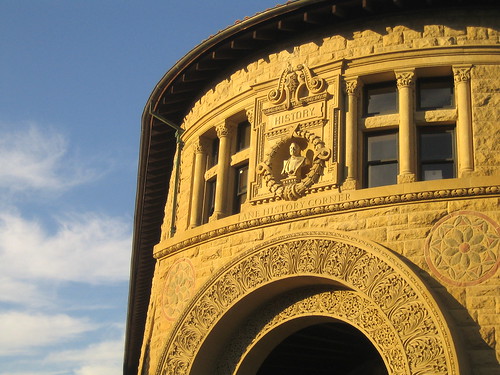
 In my years on campus, the grounds were equal part playground and muse, providing the setting for many mornings, afternoons, and nights of architectural exploration, the backdrop for much of our more lucid forays into short film-making, and generally, a beautiful place in which to mess around.
In my years on campus, the grounds were equal part playground and muse, providing the setting for many mornings, afternoons, and nights of architectural exploration, the backdrop for much of our more lucid forays into short film-making, and generally, a beautiful place in which to mess around.Now, anytime I return to northern California after an absence, and with a few days on my hands, I drive down to campus and spend a couple of hours walking around. While the campus has many beautiful secrets scattered throughout, the most stunning is still the most prominent - the original Stanford Quad.
 Built in the Mission Revival style in the 1890s, based on plans by Frederik Law Olmsted, the sandstone arcades, red-tiled roofs, and the pink-tile latticed ground stones create an atmosphere of sturdy calm from which to absorb the rich textures of light and shadow. The perfect geometries of the Quad, which stretch from University Avenue to 101 in the East, through Memorial Church and into the foothills, and further, the Pacific and the setting sun in the West, and currently, bisect Green library to the south and the prows of the ship-like face of the technology park, laid on the same axis, to the North, lend a sense of precision and mathematical formality - establishing a baseline of order and intention to the place. And the gem in the crown, Memorial Church itself, with its gilt mosaic face, cool, wooden interior, awash in rich light from the stained glass-lined nave, with its graceful and contemplative organ emoting its quiet plaints most days and some nights, provides an aura of holiness to an otherwise secular campus.
Built in the Mission Revival style in the 1890s, based on plans by Frederik Law Olmsted, the sandstone arcades, red-tiled roofs, and the pink-tile latticed ground stones create an atmosphere of sturdy calm from which to absorb the rich textures of light and shadow. The perfect geometries of the Quad, which stretch from University Avenue to 101 in the East, through Memorial Church and into the foothills, and further, the Pacific and the setting sun in the West, and currently, bisect Green library to the south and the prows of the ship-like face of the technology park, laid on the same axis, to the North, lend a sense of precision and mathematical formality - establishing a baseline of order and intention to the place. And the gem in the crown, Memorial Church itself, with its gilt mosaic face, cool, wooden interior, awash in rich light from the stained glass-lined nave, with its graceful and contemplative organ emoting its quiet plaints most days and some nights, provides an aura of holiness to an otherwise secular campus.Walking around now is less an act of nostalgia then a momentary pause to reconnect with a truly special place - a testament to how buildings and architecture can really enrich our daily lives.
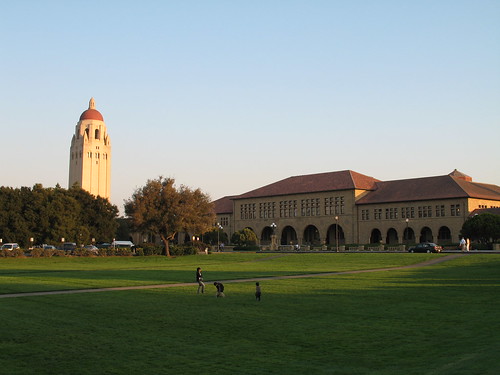
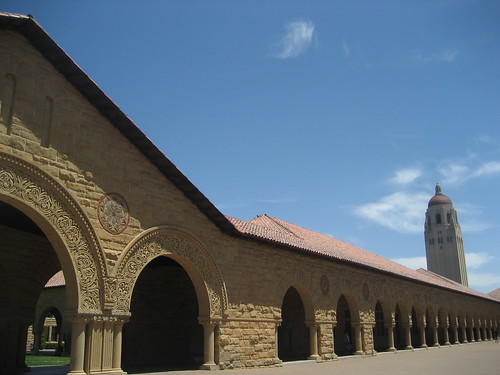

Photos of Providence Downcity
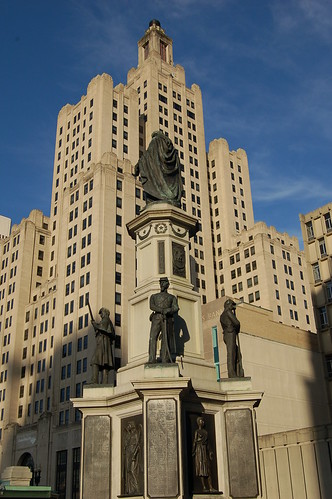



Thursday, May 24, 2007
Continued Laziness: Wired Digest
- the Miami "art collective" Friends With You. Their website is a little twee, their aesthetic hops between too-cute Japanimation whatever and glorious moments of effervescing psychotic joy, and their Rainbow Valley playground is awesome. Kids know when their worlds are rocking, right?
 - Photographer Mark Richards has some super cool photos of old computers as part of his new book Core Memory:
- Photographer Mark Richards has some super cool photos of old computers as part of his new book Core Memory:

 - The m-ch project builds modular "micro-compact homes" which embody a minimalist cool while still providing functional living accommodations:
- The m-ch project builds modular "micro-compact homes" which embody a minimalist cool while still providing functional living accommodations:



Tuesday, May 22, 2007
Dogfighting
Now, in the wisdom of the professional athlete, two Washington Redskins players decided to come to his defense, and the defense of backyard dogfighting. I don't really have an opinion on dogfighting - it seems inhumane, but I could be convinced of its place in the backwater cultural heritage of America, somewhere alongside bear-baiting. So this isn't about that. What I did enjoy was this tiny bit of sports reporting, including Clinton Portis' embrace of liberatarianism, Samuels' giggling, and their apparent secret knowledge of the sporting habits of prominent politicians. It does seem like they know something, right?
And on a different note, RM forwards me this excellent interview of Billy Graham by Woody Allen. Courtesy of mentalfloss magazine.In an interview with WAVY-TV, Portis said that if the Atlanta Falcons quarterback is charged and convicted of being involved in a dog fighting operation, then authorities would be "putting him behind bars for no reason."
"I don't know if he was fighting dogs or not," Portis said. "But it's his property; it's his dogs. If that's what he wants to do, do it."
Portis said dog fighting is a "prevalent" part of life.
Portis, a native of Laurel, Mississippi, added: "I know a lot of back roads that got a dog fight if you want to go see it. But they're not bothering those people because those people are not big names. I'm sure there's some police got some dogs that are fighting them, some judges got dogs and everything else."
"Politicians," added Samuels, who found it hard to keep from giggling while Portis was talking.
"Presidents," added Portis with a laugh.
Friday, May 18, 2007
Tuesday, May 15, 2007
Rave: Prime Green by Robert Stone

I would be lying if I said I didn't envy Robert Stone's life. From the mid-fifties through the mid-seventies, he lived at the periphery, and sometimes in the center, of the cultural storms that forever changed America. Always a keen observer, and often a less than impartial participant, Stone's life coursed through many of the truly epic times and places of the beginning of the end of the 20th century. A tough-luck childhood in Brooklyn and Manhattan, a post-war tour in the Navy, on a science boat exploring Antarctica, a return to the emerging beat movement in New York, a year in the blossoming, sultry revival of New Orleans, working with Stegner at Stanford while experimenting with Kesey in the foothills, making do in a writer's exile in Paris and London, a journalist's tenure in the crumbling landscape of a lost Vietnam, a few bleached out months in Charles Manson's Hollywood. It's all there.
Written as a lucid, honest, and intimate portrait of Robert Stone's life as he progressed through each of these memorable episodes, Prime Green is an excellent memoir - a fun read, full of momentum, but also a clearly and closely detailed portrait of a life and of an era. Charting Stone's course as he evolved from a struggling writer to a respected novelist, always probing and pushing against the boundaries of personal experience and of the culture itself, Prime Green offers a unique perch from which to absorb the drama, tumult, and delight of America's great cultural upheavals. Well worth your time.
And the NYT's excellent review here.
Monday, May 14, 2007
The Brooklyn Bridge Would Be My Lover
Spent a very fun and final and exhausting weekend with all of my BFFs from Brooklyn, as the kids put it. The end of an era, if a small and personal one. Good food, wine, and fun in the big city, and the added bonus of forcing JWW and JZ to stay up until daybreak listening to the live-audio version of what this blog covers -- i.e., my melancholic harangues. Since I'm flying out west today, and need, in the next hour, to pack, prep for some interviews, catch a bus and then a plane, all you get are a bunch of links and stuff. Some of them are a little odd:
In this our age of terror, I'm not sure if watching controlled implosions of buildings is still cool or not, but here is one from Atlanta (above) and one from Fort Worth, TX (below). Many, many more can be found on YouTube. That such violence is the efficient and acceptable way of getting this done is a sort of aesthetic incongruity in the universe, but a pretty cool one.
Which, in the context of this article from RM, makes things a little sadder. Those could have been somebody's husband.
"Man Dies in Parking Lot Dance Faceoff" is the headline. "48-year-old man has died while dancing, trying to outdo a rival with an acrobatic move while 'battle dancing,' police said," is the lede. So sad, in so many ways. That said, EBC approved a battle dance section to her wedding in Chicago this August, including a couples battle dance finale.
For all you lady pirates [CC, AM and the now-defunct Brooklyn pirate crew] out there, Slate has this:
"Everybody loves the idea of women pirates," said marketing. But I also felt that Grace O'Malley was a wonderful role model for any woman who's ever dreamed of running away to sea.Is this a dream I should have been aware of earlier?
Finally, AH sent out the following. Have the deans of the academy made an official statement on how YouTube will corrode the culture yet? Please send me a link.
Thursday, May 10, 2007
Gervais on God
And if you want a more serious take on the whole God issue, check out PK's takedown of Richard Dawkins over at Hylozoa.
And when you're done with that, well, here's more Gervais, helping Africa and making one of the better Anne Frank jokes I've hard in a while...
Wednesday, May 9, 2007
Tuesday, May 8, 2007
We'll Develop the Coast and Sell the Air...


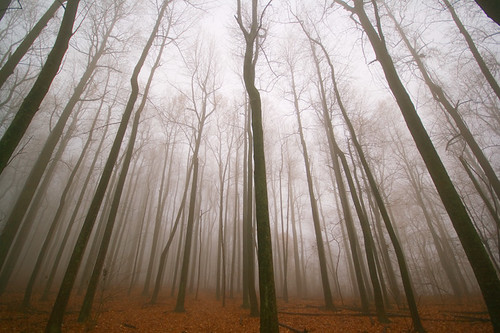

I was (and still am) convinced that the consumerist, materialist focus of society in America was disconnecting people from their physical environments -- as strip malls, subdivisions, and highways dominate the physical landscape, and the office, television, and commuting occupy people's time, Americans (including myself) are losing touch with the rhythms and textures of the natural world.
Secondly, having spent a lot of time in my youth traveling to India and other developing countries, I've always had a strong sense of the inequality between the material excess in which we indulge in America, in our houses, our cars, and the things we buy, and the proximity to abject poverty in which so much of the world lives. And even more concerning was a realization that most of the world wouldn't live that way forever -- that as countries developed, like in India and China today, the standards of consumption among some segments of the population would increase, striving to reach parity with the West. Could this possibly be sustainable?
Finally, a concern, well-founded but uncertain, was the question of sustainability itself. For years, natural scientists and economists, from Malthus at the end of the 18th century to the Ehrlichs in the 1970s have been sounding the alarm over a global environmental catastrophe. While we have managed to avoid such a catastrophe to date, perhaps by underestimating nature's resiliency or humanity's ingenuity, it is doubtful that we are in the clear. Global warming, increasing rates of extinction, depleted fisheries, massively changing global land use profiles all cause concern.
With this having drifted to the top of my mind, I figured I'd post a few interesting links focused on making more responsible environmental choices. As an additional note, all of the photos posted above were cribbed from Flickr.
- A little post I wrote about Ecological Footprinting, over on the other site.
- No Impact Man, a NYC-based writer who is trying to spend a year creating no resource impact through his lifestyle (and, admittedly, a shameless, if well-intentioned publicity stunt)
- National Resource Defense Council's website on Green Living.
- And a quick link to David Byrne's journal, which includes a quote from Einstein, relevant to this peculiar mystery:
"If the bee disappeared off the surface of the globe then man would only have four years of life left. No more bees, no more pollination, no more plants, no more animals, no more man." - Einstein
Monday, May 7, 2007
The April Reading List
 The Calcutta Chromosome, Amitav Ghosh
The Calcutta Chromosome, Amitav GhoshDarkness At Noon, Arthur Koestler
Thinking Points: Communicating Our American Values and Vision, George Lakoff and the Rockridge Institute
A Man Without A Country, Kurt Vonnegut
Uncommon Carriers, John McPhee
In general, I don't like to shop. In book stores and record stores, however, I can become compulsive. They are dangerous places. One hundred, two hundred dollars can go easily, for no good reason. Luckily, in the continuing era of funemployment, I have been able to keep a pretty good balance, between the buying and the reading.
April, 2007 came and went, with time spent mostly in Rhode Island, minus a few days each in Boston, New Haven, and New York, and a week in St. John. As the weather turns warm and beautiful on the Narragansett shoreline, I ploughed through five books, of which I can recommend none wholeheartedly and three half-heartedly. The revelations of the month are three bookstores, however, that I heartily recommend: Labyrinth Books in New Haven, Symposium in downtown Providence, and the Brown University bookstore on the East Side of Providence. Specifically, if your father has a habit of buying lots of unnecessary academic titles that eventually collect unread in an impressive study, and you can go dutch with your father, then take advantage of the 10 book-30% discount at Brown.
The only book I didn't purchase was AmitavGhosh's The Calcutta Chromosome, which IC handed to me as I was leaving Calcutta in February. Amitav Ghosh ranks among the cadre of erudite and well-regarded Anglo-Indian authors whose work I don't care for much. Not that his work is bad, but more that it lacks, on the one hand, the urgency and conviction that sets your teeth while reading, and on the other, the wit and invention to invite a smile or a knowing smirk.
The Calcutta Chromosome is essentially a ghost story, and as such, there is enough intrigue and inherent momentum to propel you through its two-hundred-odd pages. The novel relates the story of two bureaucrats in some unspecified future dystopia, and hurtles the reader backwards and forwards through time, from New York to Calcutta to mysterious villages in the Indian countryside, weaving a somewhat spooky tale about a secret society of Indian mystics who have figured out how to enable their soul's transit from one body to another.
Anchored to the quest of one of our bureaucratic heroes, Muragan to unravel the supposed mysteries of Sir Ronald Ross' search for a cure for malaria, as related to Antar, our other bureaucratic hero, the narrative weaves in enough weird and spectral elements to catch a few moments fleeting interest, but ultimately, I didn't find the novel to be sufficiently gripping as a horror story.
One minor note to be said about The Calcutta Chromosome - and more broadly, I'd generalize to writers who can stand outside the realist legacy of Hemingway and Fitzgerald, and therefore, are wiling to pay more loving homage to Arthur C. Clarke, Agatha Christie, and P.G. Wodehouse - there is a certain charm in a novel that is, in fact, a Victorian ghost story. And I can see how, if I were perhaps a little less jaded or demanding, that it could simply be considered fun, a curl-up novel that appeals to the twelve year old in me. But, unfortunately, I didn't feel this effort was strong enough to carry the day.
Arthur Koestler's Darkness at Noon is a surprisingly un-cumbersome read for an allegoric novel about the crushing illogic of totalitarian regimes in their effort to negate the soul and intellect of independent-minded individuals, centered around Stalin's Moscow show trials of the Late 1930s. Relating the trial of Rubashov, a high-ranking Party official, accused of plotting against the Party's leader, the slow, brutal acquiescence forced on Rubashov to trumped-up charges, and finally, the devolution, through torture by the state apparatus, of his independent thought and convictions, Darkness at Noon is a very useful piece of literature. The novel provides a clear and nuanced polemic illustrating the grave threat that total subservience to the state and its ideas represented to the individual, and his right/desire to have his own ideas, reflecting a moment in history when the policies of totalitarian states posed a very real threat to each and every one of its citizens.
What is most striking about the novel, however, is how irrelevant it actually feels, given some of the current political issues of the day. Specifically, while many observers lament the Abu Ghraib transgressions as an affront to American values and liberty, these affronts of the American state and military apparatus really have no bearing on the day to daylives of American citizens. Here, manifest, is the separation between totalitarian Russia and America today. Not that there isn't perhaps the same rot at the core of power, the same illogical bending of truth and morality, but rather, that, through some potent mix of democracy, commercialism, and wealth, that rot never threatens the daily lives of your average American. While the U.S. government operates secret prisons, Army officials defend torture as a military tactic, and the Republican party removes non-adherents from its political rallies, there isn't a tangible concern that you or me or anyone we know will be unable to write, much less say or think, whatever we want. Reading Koestler is a helpful reminder of the good, who we are not, and the bad, who we should be careful not to become.
Having heard George Lakoff speak on NPR more than once, and having formed a favorable, if shallowly informed, opinion of the Rockridge Institute, I was keen to read Thinking Points. Unfortunately, the value of the book can be summed up in about a paragraph. Specifically:
Language and how political discourse is framed fundamentally influences what people think about issues and candidates. Framing issues correctly can help align desired political outcomes with the core values of the electorate. Voters respond to candidates, policies, and positions at the level of values and symbols, not issues and platforms. Republicans/conservatives have done a better job at framing the political debate in the last twenty five years than Democrats/progressives. Democrats need to do a better job of articulating their core values, and subsequently, framing political issues, at the deepest levels, centered around those core values, and at more surface levels, using language that frames issue-specific debates in alignment with those values.
These lessons are well-taken and undoubtedly true. Beyond that, I found Thinking Points lacking, for failing to create cogent arguments from a myriad of interesting points, for providing little practical guidance on how to apply the supposed lessons of the book (with the exception of the useful case on Net Neutrality at the end of the book, and for, in general, being a muddle of jargoned language, half-baked case studies, and ill-defined core concepts. Additionally bothersome to me, personally, are the supposed bases of the approach in cognitive science, wrapping common-sense politics in the thin veil of science (let's not get carried away, linguists), and the shrillness of tone in its calls to action ("America today is in danger. It faces the threat of domination by a radical, authoritarian right wing that refers to itself as 'conservative,' as if it were preserving and promoting American values"). Given the hope of the book to serve as a progressive's handbook in communicating our American values and vision, Thinking Points fails to effectively define or communicate core American values, and provides vague and ill-defined advice for practically re-framing the debate.
It is probably worthwhile thumbing through Thinking Points, as there are enough common sense conclusions to be agreed with ("Be authentic and stick to what you really believe. Changing to a position that you do not believe not only lacks integrity, it's a flawed and ineffective political strategy;" "Perhaps the most effective political arguments come not in the form of arguments but in the form of stories;" "For all our political differences, we [conservatives and liberals] share far more ideals in common as Americans that one would think from all the harsh rhetoric...") But unless any of those statements are revelations to you (or unless you are both an incredibly pretentious and also ineffective and out-of-touch political operative), then feel free to skip reading through the entirety of Thinking Points.
More dismaying than the muddle of Thinking Points is the state of American politics, and particularly, the ascendancy of a brand of "conservatism" that appears, in its most generous light, to be a balance of incompetence and nefarious, oligarchic cronyism gone horribly awry. One of the saddest things about this administration is how fully they occupy the minds of otherwise noble thinkers. A shame, in fact, that one of the lasting impressions of Kurt Vonnegut's final book, effectively a memoir, is one of bitterness and disillusionment brought on by the current state of politics. For a survivor of the Dresden fire bombings, an icon of independent thinking, wit, and a perverse brand of optimism about the human spirit, this is a depressing state of affairs, that Vonnegut, in his golden years, should seemed as preoccupied with the moral and political failings of Bush and Co. as with weaving beautiful. little vignettes about New York City and dispensing enough sound advice to carry any eighteen year old clear through their late-thirties.
What does shine through in A Man Without A Country is the avuncular wisdom and mischievousness that is a hallmark of Vonnegut through the years. Declaring himself a member of the church of perpetual astonishment, and constantly aware, through his dismay, of the wonder and genuine niceness that can be found in everyday living, A Man Without A Country is the sort of book that should be presented to every high school senior to read as he takes a steamship to India for a summer before starting college.
And, at a slim 138 pages, it is perfect pocket reading for morning's subway ride, to revel in Vonnegut whimsically carry ing on about "Evolution can go to hell as far as I am concerned. What a waste we are," and "Here is a lesson in creative writing. First rule: Do not use semicolons. They are transvestite hermaphrodites representing absolutely nothing. All they do is who you've been to college," or "Do you know what a Luddite is? A person who hates newfangled contraptions," and "I have some good news for you and some bad news. The bad news is that the Martians have landed in New York City and are staying at the Waldorf Astoria. The good news is that they only eat homeless men, women, and children of all colors and pee gasoline." A Man Without A Country won't knock you off your feet, but it will bring out that knowing smile.
John McPhee's Uncommon Carriers was both my most and least favorite book of the past month. Uncommon Carriers, a collection of New Yorker essays, bring to vivid life some wonderful corners of the world of transportation, the vast and busy supply lines that make our world what it is. Ranging from riding shotgun in a long-haul trucker, to visiting a school in the French Alps which teaches the captains of supertankers various complicated maneuvers on a to-scale miniature of the world's waterways, to a ride along two mile long coal trains, to a canoe ride tracing the route of Henry David Thoreau, to a survey of the transition of UPS from simple logistics company to total supply chain powerhouse, undergirding, apparently, the entirety of American consumer industry, McPhee provides entree to the mechanics and people who make our world go.
My only quibble, which I persisted in through my entire reading of the book, was McPhee's bad habit of littering his otherwise pristine prose with a mess of jargon and vernacular, effective in adding color and atmosphere to his essays, but at the same time, feeling leaden, contrived, and pretentious. For example, in the second installment of McPhee's essay about long-haul container truck driver Don Ainsworth:
Since that day in Tacoma when I had last seen him, he had driven nearly four hundred thousand miles, in forty-six states and three Canadian provinces. He had carried liquefied clay from Sandersville, Georgia to Thunder Bay, on the Canadian shore of Lake Superior, delivering it in a blizzard. He had carried petroleum-based candle way from Titusville, Pennsylvania to West Jordan, Utah; fatty acid from Winter Haven, Florida to Roanoke, Virginia; cutting oil from Hilton, New York, to Cullman, Alabama; tall oil (pine-tree resin) from Mobile, Alabama to Oklahoma City; "elephant snot," trademarked ClariFloc from Savannah, Georgia, to a wastewater-treatment plant in Fresno, California...... and so on. While the rhythmic patter provides a fair approximation of Johnny Cash's "I've Been Everywhere," I leave such a paragraph with no less understanding of what it means to be a long haul trucker, and with the impression that, for all of the wonderful detail that McPhee provides throughout the rest of his essays, may be he doesn't, either. But it is a small quibble against style, and one that I am pressing too hard, given that McPhee's essays provide engaging and atmospheric vantages into the familiar but unknown transportation industry.
My favorite essays in Uncommon Carriers were "The Ships of Port Revel," which illustrated a vaguely cartoonish world in which a multi-national collection of ship's captains (and by ships, we're talking supertankers), gather together at a lake in the French Alps and learn the techniques of advanced ship-handling on a course made to miniature: waterways (replicas of the Suez Canal, the channels between Manhattan Island and Staten Island, Cape Hope, and Cape Fear), actual cargo ships, and water currents and prevailing winds all scaled to 1:15,625 size in a strange, high-stakes Disneyland of ship-handling, and "Out in the Sort," in which McPhee explains how UPS is more than just a shipping company. In "Out in the Sort," McPhee shows how UPS, in fact, has built a company which handles such tasks as warehousing "every last component of Bentley motor cars," employs eighty technicians who "will have the innards of your Toshiba laptop spread all over the table. They replace hard drives, main-system boards, liquid crystal displays," as an outsourced arm of Toshiba's customer support. And UPS, through its Metropolitan College, provides both incentives and the infrastructure to help its employees go to college (and to help students with financial needs become UPS employees), to the extent that "more students go to Metropolitan College than to Haverford."
My copy of Uncommon Carriers is badly weathered. Over a week on the beach, crammed into my travel bag, and occasionally left out in wind-swept rain storms, it took a beating. And although I did take issue (to the point of recurrent, irrational arguing with RM) with elements of style, it is probably the book most worth your time of those that I read in April.
Octupus, Chandalier, Necktie
 Wired on-line has a nifty set of photos about a "shape-shifting chandelier"(above). Check it out.
Wired on-line has a nifty set of photos about a "shape-shifting chandelier"(above). Check it out.Went to the RISD alumni sidewalk sale on Benefit Street in Providence yesterday. Surprisingly, and disappointingly, I disliked most of the stuff there - it was too crafty and humorless. The two highlights (not counting all the artsy girls and boys) among the vendors were some really nice designer ties from SovereignBeck and some very amusing postcards (for which I can't find the link!)
 ENW sends a link to 3quarksdaily, an excellent blog, more professional and prolific than this one, about science, art, culture, etc., leading me to this awesome collection of photos (which I believe are real sea creatures, but ENW would know better than me, what with his new island lifestyle...)
ENW sends a link to 3quarksdaily, an excellent blog, more professional and prolific than this one, about science, art, culture, etc., leading me to this awesome collection of photos (which I believe are real sea creatures, but ENW would know better than me, what with his new island lifestyle...)

 Finally, this video of the experiments conducted on the British Army to evaluate the war time effects of LSD has made the rounds once before, but it's still worth a look.
Finally, this video of the experiments conducted on the British Army to evaluate the war time effects of LSD has made the rounds once before, but it's still worth a look.Friday, May 4, 2007
Mixed Bag
 The sportfishing boat that RM used to catch a shark (that's right, a shark) was the Mixed Bag. Also, the title of today's post, with no commentary and only links, to while away the hours between lunch and after work drinks:
The sportfishing boat that RM used to catch a shark (that's right, a shark) was the Mixed Bag. Also, the title of today's post, with no commentary and only links, to while away the hours between lunch and after work drinks:- The NY Sun writes up Don Delillo's post-9/11 novel, "Falling Man."
- The New Yorker profiles Manny Ramirez, with this excellent quote:
When I asked his teammate David Ortiz, himself a borderline folk hero, how he would describe Ramirez, he replied, “As a crazy motherfucker.” Then he pointed at my notebook and said, “You can write it down just like that: ‘David Ortiz says Manny is a crazy motherfucker.’ That guy, he’s in his own world, on his own planet. Totally different human being than everyone else.”
- Big Sky Brooklyn has some very familiar photographs and observations for all of us who have put down roots, however deep or shallow, in beautiful Brooklyn, NY.
- MM turned me on to this excellent and ambitious bit of graffiti.
- Profiled on Colbert, the Dangerous Book for Boys seems like a great gift idea for a twelve year old.
- Finally, an incredibly sad story about a sweet little girl and the horrible people at American Girl Place.
Thursday, May 3, 2007
The April Raves List
Night Ripper, Girl Talk
Jailbreak, Thin Lizzy
Movies
The Siege
Batman Begins
Food & Drink
Istanbul Cafe in New Haven, CT
Kingston Pizza in Kingston, RI
Woody's in Cruz Bay, St. John's, USVI
Misc.
Sportfishing, of the not-throwing-up-for-four-hours variety
Purt-Ny-Shee above Chocolate Hole, St. John's, USVI
Celebrity, the party game
$50 Adidas Telstars
Symposium Books in Providence, RI
Brown University Bookstore's 30% discount (in Providence, RI)
Kaka, Seedorf, Pirlo, Gattuso, and Ambrosini (the AC Milan midfield)
A Charming Little PR Campaign

Tuesday, May 1, 2007
Nothing to Add...

“This guy’s the champion,” said Patricia Brennan, a behavioral ecologist, leaning over the nether regions of a duck — a Meller’s duck from Madagascar, to be specific — and carefully coaxing out his phallus.Read on.
Two Reasons to Love Spanish Football + Kaka at Old Trafford Last Wednesday
Finally this week, it behoves us to mention the 62nd minute of Barcelona v Levante. This was the moment in which Oleguer Presas, Barça's politically prominent defender, was brought onto the field in substitution of Gio. The next significant moment was when Salva, Levante's equally politically prominent forward, was taken off the field after 76 minutes, which meant fourteen minutes during which something akin to the Spanish Civil War was re-enacted on the pitch at the Camp Nou. Thankfully, the players kept their distance, but Salva had been subjected to a high decibel count from the seventh minute, when he first touched the ball.
In case you don't know, in mid' February Oleguer, who has stepped into Guardiola's boots as the Barça-player-who-needs-to-keep-things-political, wrote an article in the Setmanari de Comunicació Directa (a magazine associated with the Catalan youth movement) which was also published in the Basque nationalist paper Berria. Nothing wrong with that, of course, in a democratic state, except that Oleguer was using the article to ask the question of whether he was indeed living in a democratic state. He's not the first person to do so, but his use of the case of the Basque hunger striker Iñaki de Jauna Chaos was, if not unfortunate, then at least guaranteed to raise the temperature of the Spanish Right by several predictable degrees. Oleguer, of course, is the same player who caused controversy two years ago by stating that even if he were picked for the World Cup squad, he would 'prefer' not to play, for political reasons. Luis Aragonés decided to avoid the growing storm and dropped him like the hot potato he was.But the present controversy might not have happened, however, had the article not come to universal prominence through the reaction of Salva Ballesta, Levante's centre-forward and a player who has made little attempt to hide his own political views over the years. Salva, from a family with a military background, wears boots that sport the Spanish flag and celebrates his goals with the army salute. Nothing wrong with that either, except that Salva has made remarks in the press before that have been at best unfortunate, and this time, on the right-leaning radio station Cadena Ser, Salva was asked his opinion of Oleguer's article. Demonstrating the intellectual rigour of the average carrot, Salva declared that he considered Oleguer's article to be 'less than a piece of dog-shit'. Oleguer, of course, declined to join the slanging match, but everything was nicely set up for the Camp Nou.
Oleguer has been having a tough time of it since the article, and has been roundly booed in several stadia - which rather demonstrates his point about free speech, but anyway, it's a tricky issue. It was kinda nice, however, to see Salva get a few decibels back - although it was clear from his reaction as he walked off that he was happy as a sand-boy to be thus acknowledged by the ideological enemy.
Without wishing to take sides, such scenes sum up a side of Spanish football that is as fascinating as it is depressing. Salva hasn't gone quite so far as Di Canio, but you can be sure that he has pictures of the Italian player on his bedroom wall.
When people bemoan the fact that footballers are dumb airheads, they applaud when said players run out onto pitches to campaign against racism, to campaign against whatever - in acts that are rarely their initiative. Players speak a sort of language to the press that habitually says nothing, and their fame is rarely used for anything beyond the obvious. So when they get political, and write books (Oleguer has done that too), something gets wobbly in the state of sport.




